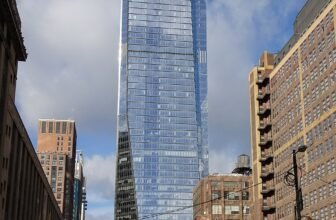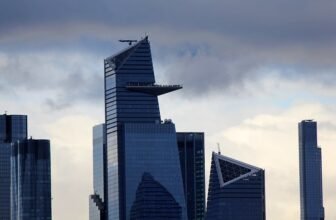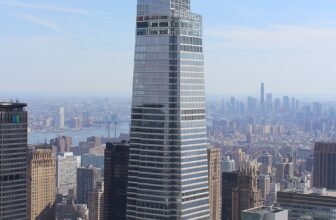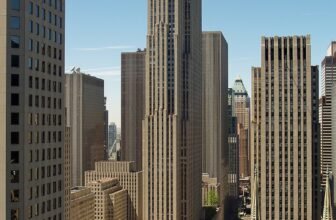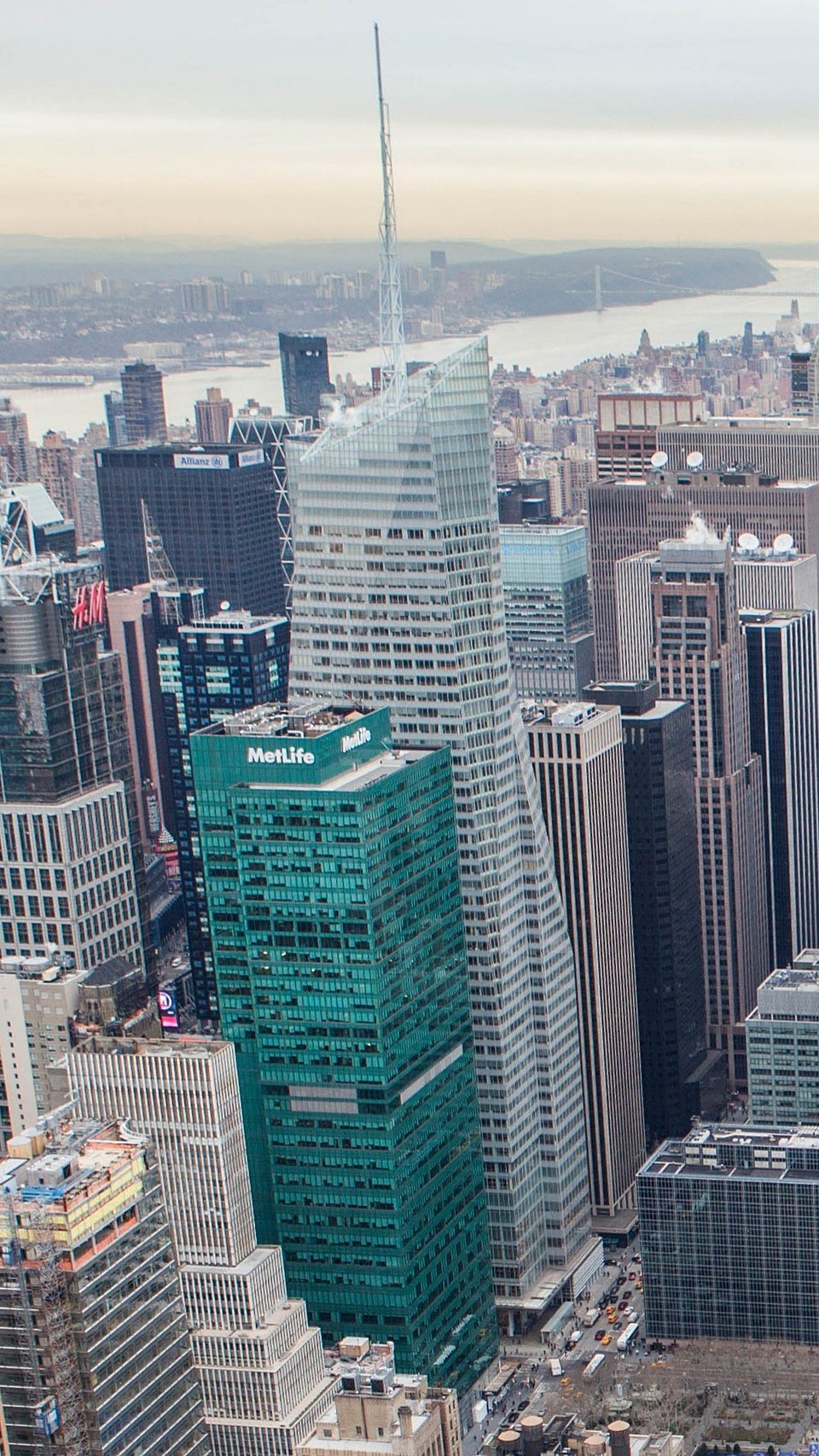
A Monument to Modern Dallas: The Story of the Bank of America Tower
In the ever-evolving skyline of Dallas, Texas, one building stands out not just for its height but for the architectural poise and historical weight it brings to the city’s commercial core, the Bank of America Tower. Towering over the downtown with an unmistakable green glow by night and a glassy brilliance by day, this skyscraper is not merely a fixture of the city’s financial prowess but a beacon of its architectural ambition.
A Skyline’s Signature: Introducing the Bank of America Tower
Situated at 901 Main Street, the Bank of America Tower is a 72-story skyscraper that commands attention not only due to its stature, standing at 921 feet (280.7 meters), but also because of the signature green argon outline lighting that illuminates the building at night, giving it a futuristic, almost ethereal glow that has become emblematic of Dallas.
This glowing perimeter lighting was a bold design choice, emblematic of the building’s identity, and today it is a point of pride, making the tower one of the most recognized buildings in Texas.
Originally known as the RepublicBank Center, and later renamed the NCNB Tower and Nation’sBank Plaza, the building took on its current name in 1998, following the merger between Bank of America and NationsBank.
The Timeline of a Titan: How Long Did It Take to Build?
The journey to raise the Bank of America Tower was not a quick one, it was, rather, a demonstration of strategic ambition and engineering prowess. Construction officially began in 1983, and after three intensive years of planning, engineering, and building, the tower was completed in 1985.
Thus, it took approximately two years of physical construction, from foundation to finish, and nearly a year of pre-construction planning. Given the scale and complexity of the project, completing such a monumental structure in that time frame was an extraordinary feat.
The skyscraper was designed to serve as a centerpiece of Dallas’ burgeoning downtown revival during the 1980s, and its timely completion allowed it to fulfill that vision exactly as intended.
A Tower Among Giants: Floors and Functions
The Bank of America Tower comprises 72 floors, making it the tallest building in Dallas and the third-tallest in Texas, trailing only Houston’s JPMorgan Chase Tower and Wells Fargo Plaza. Its floor count doesn’t just reflect verticality, it speaks to the building’s versatility and capacity. These 72 floors are home to a range of high-profile tenants, including law firms, financial institutions, tech companies, and, of course, Bank of America itself.
Beyond the towering floors, the structure also boasts a massive footprint with over 1.9 million square feet of office space, offering both luxury and functionality to its tenants. The design incorporates state-of-the-art elevators, flexible office configurations, and high-grade conference and amenity spaces to accommodate a dynamic workforce.
Ownership and Stewardship: Who Owns the Bank of America Tower?
As of the most recent updates, the Bank of America Tower in Dallas is owned by Dallas-based Woods Capital, a real estate investment firm with a strong portfolio in major urban redevelopment. Woods Capital acquired the building in 2019, setting forth a renewed vision to revitalize and reposition it for the next generation of business and architectural innovation.
The acquisition marked a key transition point in the tower’s story, as Woods Capital initiated a series of updates and renovations designed to modernize the building while preserving its iconic status. This includes upgraded lobbies, enhanced amenity spaces, energy efficiency improvements, and state-of-the-art tech infrastructure. Their stewardship has been marked by a commitment to sustainability and maintaining the tower’s place as a top-tier address in Dallas’ central business district.
The Architecture: Bold Geometry and Futurist Flair
The design of the Bank of America Tower is the work of the prestigious architectural firm JPJ Architects, a collaboration among three notable firms: Jarvis, Putty, Jarvis. They envisioned a skyscraper that would not only symbolize economic strength but also captivate onlookers with its aesthetic appeal.
The building’s structure is a striking example of late modernist architecture, characterized by geometric clarity, symmetrical forms, and minimalist facades. Clad in a reflective blue-green glass curtain wall system, the building gleams in daylight, mirroring the Texas sky and surrounding structures, creating a dynamic visual experience for observers from any angle.
Perhaps the most defining visual element of the tower is its stepped and chamfered corners, which break up the bulk of the facade and lend it a crystalline appearance. At night, the neon green lighting system along these corners transforms the tower into a glowing beacon, a feature that has earned it a spot in countless photographs, films, and local lore.
The design of the building also integrates with its urban context. It connects to Dallas’ underground pedestrian tunnel system, linking it with other key buildings downtown, and thus reinforcing its role as an integral hub in the city’s daily rhythm.
The Cultural Footprint: More Than Just a Building
Beyond its physical presence, the Bank of America Tower has permeated Dallas culture and identity. It is often the building that locals refer to when describing the skyline, and it frequently features in media depictions of the city. Its iconic lighting, visible from miles away, often changes colors for local events and causes, showing solidarity with community initiatives.
The tower has also made appearances in various movies and television series filmed in Dallas, serving as both a backdrop and a character in the city’s ongoing story.
Furthermore, the tower represents a commitment to civic pride. Despite economic fluctuations and downtown vacancies that have challenged urban cores across America, the Bank of America Tower has remained a stronghold of vitality in Dallas, always adapting, always glowing.
Renovations and Rebirth: Keeping the Legacy Alive
Since its acquisition by Woods Capital, the Bank of America Tower has undergone significant renovations. These include:
-
Lobby upgrades with contemporary art installations and high-end finishes.
-
Enhanced amenities like collaborative lounges, meeting rooms, wellness centers, and dining spaces.
-
Technology improvements, including high-speed elevators, smart access systems, and fiber-optic internet.
-
Sustainability initiatives, aimed at reducing the building’s carbon footprint through energy-efficient lighting, HVAC systems, and recycling programs.
The goal of these updates is clear: to maintain the tower’s relevance in a world where workspaces are rapidly evolving, and to appeal to the new generation of urban professionals who demand both style and substance.
A Symbol of Dallas, A Symbol of Progress
The Bank of America Tower isn’t just a financial center or a workplace, it’s a symbol. A symbol of Dallas’ rise as a global city. A symbol of architectural innovation and civic aspiration. From its humble beginnings in the 1980s economic boom to its present-day resurgence as a high-tech, sustainable skyscraper, it embodies the story of a city that never stops reaching higher.
Whether you’re gazing up at its illuminated edges from Main Street or catching a view from a passing airplane, the tower’s impact is undeniable. It stands not just as a part of the Dallas skyline, but as a pillar of the city’s past, present, and future.
Fast Facts Recap
-
Name: Bank of America Tower (formerly RepublicBank Center, NCNB Tower, NationsBank Plaza)
-
Location: 901 Main Street, Dallas, Texas
-
Height: 921 feet (280.7 meters)
-
Floors: 72
-
Completed: 1985
-
Construction Duration: Approximately 2 years
-
Architect: JPJ Architects (Jarvis, Putty, Jarvis)
-
Owner: Woods Capital (as of 2019)
-
Design Style: Modernist with postmodern neon lighting
-
Special Features: Green neon lighting outline, connected to the Dallas underground pedestrian tunnel system, massive floor plate for flexible office spaces
-
Tenants: Bank of America, law firms, tech companies, various commercial offices
An Enduring Giant
As we trace the silhouette of the Bank of America Tower against the Texan sky, we’re not just witnessing an architectural achievement, we’re observing a narrative of resilience, innovation, and adaptation. From its bold construction in the 1980s to its modern-day revival under new ownership, the tower continues to reflect the spirit of Dallas: ever forward, ever upward.
And in that spirit, it will no doubt continue to inspire, serve, and define the city for decades to come.


